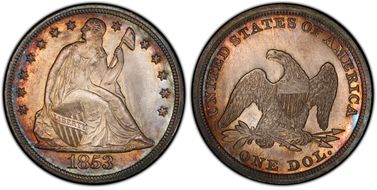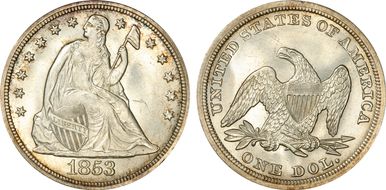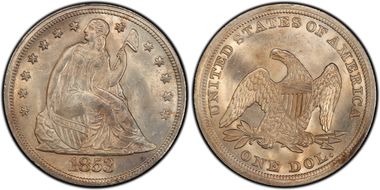1853 $1 XF45 认证号12057236, PCGS号6941
拥有者评论
专家评论
Ron Guth
The 1853 Silver Dollar is popular with collectors because of its small mintage of 46,110 pieces. Fortunately, a high percentage of these cojns were saved, making it easy for collectors to obtain an example. The same is true of Mint Stte examples, which exist by the scores in MS62 to MS64. Above MS64, the 1853 Silver Dollar becomes an important condition-rarity. The PCGS CoinFacts Condition Census starts at MS64 and tops out at MS66, with none seen in finer grades. Burce Morelan's PCGS MS66 is arguably the best of the bunch.
Curiously, the Silver Dollar was excluded from the changes in the Coinage Act of February 21, 1853 (in which the weights of all U.S. silver coins were lowered with the exception of the Three-Cent Silver and the Dollar). As a result, there was no reason to place arrowheads on either side of the date on the 1853 Silver Dollar.
Q. David Bowers
The following narrative, with minor editing, is from my "Silver Dollars & Trade Dollars of the United States: A Complete Encyclopedia" (Wolfeboro, NH: Bowers and Merena Galleries, Inc., 1993).Coinage Context
The Act of 1853: By early 1853, the price of silver had risen on the international market to a point at which earlier Liberty Seated coins of various denominations, originally issued at face value, were being bought up by banks, bullion dealers, and brokers and melted down or exported. To continue to issue more such coins in quantity would have been an exercise in futility.
The Act of February 21, 1853 mandated a lowering of the weight of silver coins from the half dime through the half dollar but left the dollar untouched, a discrepancy frequently mentioned as an omission in various later annual Mint reports. The legislation was effective, and from 1853 until hoarding began in earnest in July 1862, large mintages plus the lack of a reason to melt coins combined to make issues from the three-cent piece to the half dollar very plentiful in commercial channels. By 1854 the silver coin crisis was over. However, as silver dollars were now worth more as bullion than as coins, they no longer circulated at par.
In his memoirs, Senator John Sherman observed: (John Sherman's Recollections of Forty Years in the House, Senate, and Cabinet, Vol. I, p. 46]) "No mention of the dollar was made in the Act of 1853. It had fallen into disuse and when coined was exported, being more valuable as bullion than coin."
The silver dollar mintage of 1853 was fairly generous for the period. As the first delivery was not until April 21, 1853, I assume that no dollars of this date circulated at par. Those minted in April and again in December (none was made in the meantime) apparently stayed within the borders of the United States, or at least the majority of them did, for dollars dated 1853 are more plentiful today than are those of the next several years.
Banks holding dollars: In April 1853, The Bankers' Magazine (p. 1004) noted the following: "The Mint will be abundantly supplied with silver for the creation of small coins contemplated by the late act of Congress. The Western banks have cut back their silver, awaiting the passage of the new Mint law. A shipment of $400,000 in silver was made by the several Louisville banks last week to the Philadelphia Mint. There are large sums, in dollars and half dollars, held by the banks of Indiana, Tennessee and other states, which will now be brought forward for recoinage."
This suggests that large numbers of Liberty Seated dollars were being held by banks as an investment, and were "brought forward" to be sold at a profit to the Mint, to be recoined into lighter weight coins (of the denominations from the half dime to the half dollar).
The entire situation of the utility of the silver dollar in the channels of American commerce during this time, indeed since the early 1840s, draws different interpretations and conclusions. However, as Senator Sherman, quoted above, and various Mint documents also relate, the Liberty Seated silver dollar was not seen in American circulation from spring 1853 until well into the 1870s. As noted earlier (under 1848), it is likely that beginning in 1848, many previously-minted coins were withdrawn from domestic use in commerce.
Neil Carothers stated that the silver dollar had never circulated generally and had been entirely unknown since 1806. (Fractional Money, footnote p. 120.)
Changes in 1853: R.W. Julian comments as follows: (Specific contribution to this book, February 1992.)
Beginning in 1853 the owner of silver bullion, who did not have a ready market for his goods, could either sell the silver to the mints to be used for subsidiary silver or have it made into dollars. There was a minor coining charge (.005 or 0.5%) for this service. The depositor could not get subsidiary silver for his bullion, although Director James Ross Snowden, to encourage sales of silver to the 'Philadelphia Mint, set an arbitrarily high price for such purchases and then paid off the depositor in subsidiary silver. This was illegal under the 1853 law and was not stopped by the Treasury until 1858.
The coinage of silver dollars after 1853 was almost totally on private account and reflected the amount of bullion deposited. There were some dollars coined on government account but the number was negligible because of accounting problems. Most of the dollars sold to visitors and collectors were Proof dollars, which cost $1.08 -in silver or gold until 1859 and then $1.60 during 1860-1861; after 1861 only Uncirculated pieces were available at the usual $1.08 in coin. No silver dollars were coined for circulation in 1858 because no one had any need for them.
At no time did merchants or banks purchase silver dollars for $1.08 each. unless they needed a mere handful for some special purpose. Heavy coinages were always made with silver bullion deposits. Some of this bullion was purchased on the open market, but most came through bullion dealers and mine owners.
Numismatic Information
Circulated grades: Some 46,100 dollars were struck of this date, and today they are scarce but are seen more often than any other Philadelphia Mint coin of the decade of the 1850s. Why this is the case is not certain, but the answer must lie in the method of distribution. While many were shipped overseas, significant numbers must have remained within the United States.
Here is a mystery, one of many within the Liberty Seated dollar series. Perhaps some future contributor to The Gobrecht Journal will come up with some ideas and share his thoughts with all of us.
Two obverse dies were made for this issue, but it is not known if both were used on circulation strikes (one may have been used years later for Proof restrikes; see below). In circulated grades the 1853 is elusive; as the mintage of 46,110 suggests, but is still the most available Liberty Seated dollar issue of the early 1850s. For some reason, Mint State pieces (see below) are seen much more often than other dates of its era (such as 1854 and 1855). Top grade circulation strikes have deeply frosty surfaces with no suggestion of prooflike characteristics. Sometimes the stars are lightly impressed.
Mint State grades: I believe that somewhere a small hoard of Mint State pieces of this particular date came to light in the 1970s or early 1980s, but I have seen no notice of such in print. Prior to this, Uncircul1ated 1853 dollars were very rare. Most Mint State, coins are brilliant or lightly golden toned and are very frosty (rather than prooflike in areas), and seem to have come from a common source (in contrast to pieces from different sources, which have a wide variety of toning, handling marks, etc.). In any event, the 1853 is the only readily available Mint State Liberty Seated dollar of its immediate time frame.
Varieties
Circulation strikes:
1.Normal Date: Breen-5449. Two obverse dies were made for circulation strikes, but these have not been differentiated in the literature. The vast majority of 1853 circulation strike dollars are of the so-called "Chin Whiskers" variety, with die finish lines extending downward from the chin of Miss Liberty, a feature seen on certain other issues as well. Are the with-whiskers and without-whiskers coins from different dies? If not, and if all known circulation strikes are from one obverse die, perhaps the restrikes (see below) were from the second obverse die known to have been made in 1853.
Dies prepared: Obverse: 2; Reverse: 1
Circulation strike mintage: 46,110; Delivery figures by day: April 21: 39,000; December 29: 7,110.
Estimated quantity melted: Unknown
Characteristics of striking: Usually occurs well struck; however, there are exceptions, and some have weak stars, especially stars 9 through 13.
Known hoards of Mint State coins: Possibly a small hoard of Mint State coins existed at one time (see text)
Additional Information
Effects of the Coinage Act
The Coinage Act of February 21, 1853 brought vast changes to the American monetary system. The weights of silver coins from the half dime to the half dollar were reduced, and the pieces were made subsidiary. To denote the difference, arrowheads were placed alongside the date, a practice continued through 1855.
Silver coins, except the dollar, were now worth more as coins than as metal, and they began to freely circulate. A number of people, including later historians, wrongly thought the United States was going on the gold standard by debasing the silver coins. However, they overlooked the fact that the silver dollar was not changed. (Carothers, Fractional Money, p. 117. Further (per R.W. Julian, letter to the author, March 10, 1992): "The U.S. did go on the gold standard in 1853, although on a de facto basis. It was not until 1873 that de facto became de jure. This fact seems to have escaped most 19th century writers on economics.") The silver crisis was over by 1854, at which time demand (and mintages) for the silver three-cent piece and the gold dollar plummeted; both of these denominations had helped fill the needs of commerce in the early 1850s when silver coins from half dimes upward were hoarded or melted. As it turned out, by November 1856 an ounce of standard silver (.900 fine) sold for $1.24 on the market in terms of gold (an ounce of pure silver was worth $1.38). If the market had risen above $1.25, then $1 face value in silver half dimes, dimes, quarters, or half dollars would have been worth $1 in gold, and a price rise beyond that would have caused hoarding and melting of silver, as occurred in the early 1850s. The situation was perilously close. The same thing would recur decades later in 1919 when silver rose sharply on the market.
In 1853-1854, as newly coined lightweight silver coins began to fill the channels of commerce, foreign silver coins lost much of their utility. Many were turned in to the Mint and recoined into American silver. Most were well-worn Mexican 2-real pieces. In 1857, Director of the Mint James Ross Snowden estimated that $25 million in silver coins was in domestic circulation, of which $20 million was in half dimes, dimes, quarters, and half dollars minted since February 1853, $2 million was in well-worn older (pre-1853) United States coins, and $3 million was in Mexican and other Spanish American fractional issues.
In 1853 the Mint was paying 23-1/2 cents, 10-9/10 cents, 5-1/5 cents for 2-reals, 1-real, and half-real (medio) coins, which was slightly higher than the regular ratings of 23, 10 and five cents allowed in other payments to the government. These higher rates at the Mint seem to have been intended to hasten the withdrawal of foreign coins. (Carothers, Fractional Money, pp. 138-139.)
In the meantime, many copper coins, particularly cents, accumulated in Northern cities. The cost of producing and distributing large copper cents had risen to the point at which Director Snowden said that they "barely paid expenses. At the Mint, experiments were conducted to make cents thinner, narrower, and lighter. Numerous patterns were made.
An announcement made by the United States Mint, Philadelphia, April 5, 1853, stated that "The law regulating the new coinage of silver leaves it optional with the director of the Mint to pay in whatever denomination of coins he prefers. It has been deemed that quarter dollars are the most useful of all silver coins, the whole force of the Mint is now at hand and has been engaged since the first of April upon them only. It is useless, therefore, for parties 'to order returns in various coins." The situation changed later; the Mint made large numbers of dimes and half dimes.
On July 27, 1853 James Ross Snowden, director of the Mint, noted that from and after August 15 payments for silver purchased for the Mint at Philadelphia and the branch mint at New Orleans will be made three-fourths in silver coin of the new standard and one-fourth in gold.
Information about the July 27, 1853 statement is from a report in The Bankers' Magazine, September 1853, p. 263.
Profits Under the Law of 1853
In a statement given to the U.S. Senate years later, as part of a study of the Coinage Law of 1873, Frank G. Winn, of New Hampshire, discussed the earlier Coinage Law of 1853, noting in part:
"The Law of 1853 had abolished the coinage of our minor silver coins for private account, but by a ruling of Mr. Guthrie, secretary of the Treasury under President Pierce, the Mint was ordered to receive silver from private individuals and coin it.
"This ruling furnished- the opportunity for an immense profit to the coin and bullion broker, and he did not fail to take advantage of it. Our silver dollars, having a nominal value of 100 cents, were collected by him, taken to the mints, and coined into minor coin; every two dollars yielded four half dollars, a dime, and almost a half dime. Here was a profit of 7% .... "
Concerning the preceding, R.W. Julian commented:
"This is a garbled account of the Snowden practice of paying high rates for silver bullion with minor silver coins. All kinds of strange statements were made after the 'Crime of '73' became a popular whipping boy for economic ills. Don Taxay reports some that border on fantasy."
New Designs Wanted
Director James Ross Snowden felt that designs of circulating silver coins could be improved, and in 1853 he made an effort to enlist outside help. Heretofore, Mint artists had made most designs. However, occasionally the Mint enlisted an outside artist. Examples include Gilbert Stuart and John Eckstein for the Draped Bust/Small Eagle dollars of 1795-1798, Thomas Sully and Titian Peale for the Gobrecht dollars of 1836-1839 and the related half dime to half dollar coinages of the late 1830s, and Robert Ball Hughes for the Liberty Seated coins (with drapery) from 1840 onward.
The Annual Report of the Director of the Mint, 1853, commented as follows:
"The results of the overture recently made to artists and other persons of taste to present designs for the silver coinage have not been satisfactory. Many designs, and some medallions, were presented, some of them of considerable merit, but the general deficiency consisted in a want of adaptation to the object in view. In making any important changes in the designs of the coinage, it seems proper that those which are to be substituted should be of decided and incontestable superiority. The result of the effort has thus produced a conviction favorable to the designs heretofore adopted and in use; our attention will therefore be turned to their artistic improvement, without materially changing their national or emblematic character." In short, Snowden applied the "Not Invented Here" principle.
稀有性和存量估计 了解更多
| 所有评级 | 1700 |
| 60或以上 | 120 |
| 65或以上 | 2 |
| 所有评级 | R-4.7 |
| 60或以上 | R-7.8 |
| 65或以上 | R-9.9 |
| 所有评级 | 17 / 30 TIE |
| 60或以上 | 25 / 30 |
| 65或以上 | 7 / 30 TIE |
| 所有评级 | 27 / 45 TIE |
| 60或以上 | 35 / 45 |
| 65或以上 | 8 / 45 TIE |























